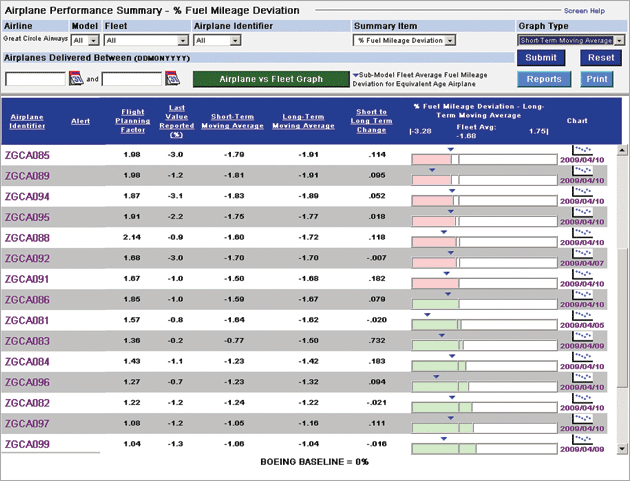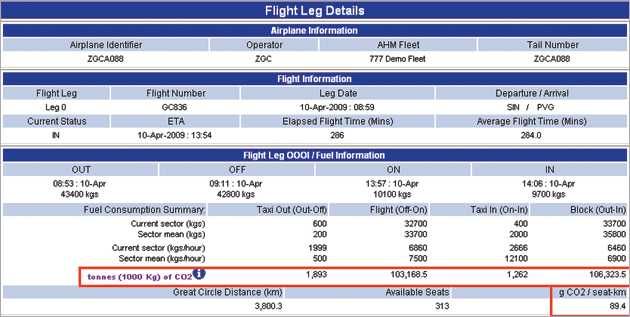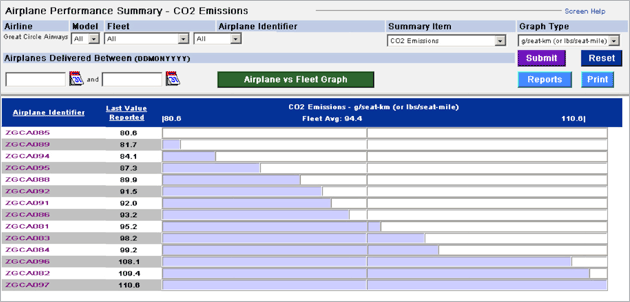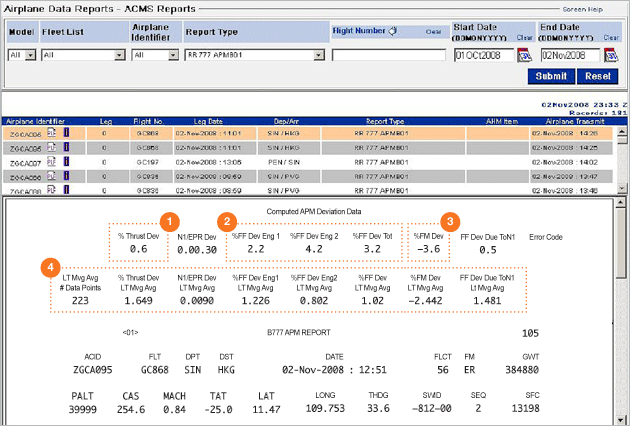
Through timely and streamlined identification and diagnosis of issues, Airplane Health Management (AHM) provides significant overall fuel and emission performance measures for individual airplanes, enabling operators to improve overall average fleet performance.
By John B. Maggiore, Senior Manager, Airplane Health Management, Aviation Information Services; and
David S. Kinney, Associate Technical Fellow, Airplane Health Management, Aviation Information Services
AHM is an information tool designed by Boeing and airline users that collects in-flight airplane information and relays it in real time to the ground. The Performance Monitoring module within AHM provides automated monitoring of fuel consumption and calculation of carbon dioxide (CO2) emissions. Airlines can use this information to optimize the operation of individual airplanes as well as entire fleets.
This article provides background on the overall AHM tool, explains the goals of the Performance Monitoring module, and shows how automated monitoring of key indicators — such as fuel consumption and CO2 emissions — can help airlines have a direct impact on the environment and improve their operational efficiency.
AHM BACKGROUND
AHM is a maintenance decision support capability provided through the MyBoeingFleet.com Web portal. AHM uses real-time airplane data to provide enhanced fault forwarding, troubleshooting, and historical fix success rates to reduce schedule interruptions and increase maintenance efficiency. It delivers relevant information whenever and wherever it's needed — data received directly from airplanes is delivered by Boeing within the MyBoeingFleet.com Web portal.
AHM integrates the remote monitoring, collection, and analysis of airplane data to determine the status of an airplane's current or future serviceability or performance. An airline's engineering and maintenance staff can use this data to make timely, economical, and repeatable maintenance decisions that can help improve overall fleet operation. (More information about AHM can be found in AERO third-quarter 2007, which outlines how AHM works, aircraft data used, and benefits to airlines.)
AHM is designed to be easy to implement and operate. The fee-based service requires no incremental cost for aircraft communications addressing and reporting system (ACARS) if the airline is already down-linking the related reports.
The Performance Monitoring module is one of three types of decision support available through AHM. (The others are Real-Time Fault Management and Service Monitoring.)
PERFORMANCE MONITORING MODULE
The AHM Performance Monitoring module uses Boeing airplane performance monitoring (APM) and health management technology to provide automated monitoring of fuel consumption and CO2 emissions. The module enhances viewing, managing and researching of, and acting on, airplane performance data to optimize airplane operation and support maintenance decision-making (see fig. 1). The module also provides a linkage between the performance and maintenance domains, allowing for a common toolset that addresses system's condition and fuel performance.
Figure 1: AHM provides performance information for a single airplane or an entire fleet
Through timely identification and diagnosis of in-service issues, Performance Monitoring provides significant overall fuel and emission performance measures for individual airplanes and, thus, improves overall average fleet performance.

Specific data provided by the module includes:
- Performance comparisons across airline and the larger monitored Boeing fleet.
- Flight planning factors.
- Per-flight and fleet CO2 emissions (e.g., emissions per seat-kilometer) (see figs. 2 and 3).
- Exception-based alerting.
- Integration with engine original equipment manufacturer condition-monitoring alerts.
Figure 2: AHM collects fuel usage data and automatically calculates CO2 emissions
Performance Monitoring automates remote monitoring of airplane CO2 emissions via automatic calculation of fuel-used information. AHM uses an industry-accepted multiplier to then calculate resulting CO2 emissions. Summary of emissions in metric tonnes for the flight and kilograms of CO2 per seat-kilometer provide airline visibility to support environmental initiatives.

Figure 3: CO2 emissions for individual flights and across the fleet
Summary reports provide airlines with total emissions for fleet or sectors, providing a complete picture of environmental performance relating to flights.

The module can provide operators with timely alerts of difficult-to-detect performance degradation by clearly showing specific deviations within the fleet (see fig. 4).
Figure 4: The Performance Monitoring module
Performance Monitoring automates remote monitoring of airplane fuel mileage and associated parameters through alerting of sudden changes as well as gradual degradation. This provides operators with information that can be used to adjust airplane performance factors, analyze performance issues, and make comparisons with other airplanes within the fleet.

- 1 % Thrust Required Deviation
- 2 % Fuel Flow Deviation — All Airplane Per Engine
- 3 % Fuel Mileage Deviation
- 4 Long-Term (90-Day) Moving Average Statistics
PERFORMANCE MONITORING PROCESS
Much as airplane condition monitoring systems (ACMS) have facilitated more consistent, complete, and convenient collection of higher-quality data on board the airplane, AHM automates the time-consuming and tedious ground processing of the performance data. Many airlines have implemented a formal performance monitoring process. The typical performance monitoring process involves five steps:
1. Record cruise data.
Once tight atmospheric and airplane criteria for stable cruise have been achieved, the ACMS records air data, engine, and airplane performance parameters over a period of several minutes. The resulting data can be sent to the ground via the ACARS in a summary report. Some airlines choose to store the summary reports on board the airplane (such as on the quick access recorder) for later retrieval and analysis.
AHM receives and processes the ACARS data for each airplane model, airline, airplane, and flight within minutes of receiving it from the airplane.
2. Convert data to a format that can be read by Boeing APM software.
The wide range of ACMS capabilities and summary report formats require translation of the data into the digital standard interface record format. Similarly, manually collected data must be converted to manual standard interface record format. These format standards are required for correct and complete computations.
AHM ensures that the data interpretation and translation are complete and consistent across a wide range of ACMS reports.
3. Analyze data with Boeing APM software.
APM applies off-nominal data adjustments to ensure the data and database are consistent, compares results for each data point to chosen baseline levels for the same flight conditions, and averages the results for all data points into selected time periods, observing deviation trends as functions of time.
AHM presents the resulting performance deviation computations and trends in a banner across the top of the ACMS summary report (see fig. 4).
4. Interpret results.
Once the deviations in fuel mileage, fuel flow, and thrust required have been computed, the airline's performance engineers can interpret the data. They assess the data for reasonableness and examine whether changes are required in flight planning and flight management computer (FMC) factors. These factors are key to ensuring that the proper amount of fuel is loaded for each flight and are fundamental in order to save fuel and reduce emissions.
AHM automatically assesses the data and reports any trends that exceed airline-defined thresholds. AHM also monitors the data for abrupt changes and isolates the cause so it can be corrected quickly. This advanced processing can identify problems long before traditional analysis methods.
5. Take appropriate action.
With fully interpreted and updated performance information, airline performance engineers can update flight planning and FMC factors for improved reserve and total fuel loading. The performance information may also indicate a requirement for planning maintenance actions, such as engine compressor washes or flight control rigging checks.
Summary
The AHM Performance Monitoring module enhances and automates the management of issues that affect fuel mileage and CO2 performance. AHM enables an airline's performance professionals to initiate necessary actions within hours — rather than the weeks required by traditional analysis methods — saving time, fuel, resources, and, as a result, money.
AHM may also help automate operators' compliance with CO2 requirements, such as the European Union Emission Trading System monitoring, reporting, and verification of tonne-kilometer data.
For more information on AHM, please contact John Maggiore or Dave Kinney.

